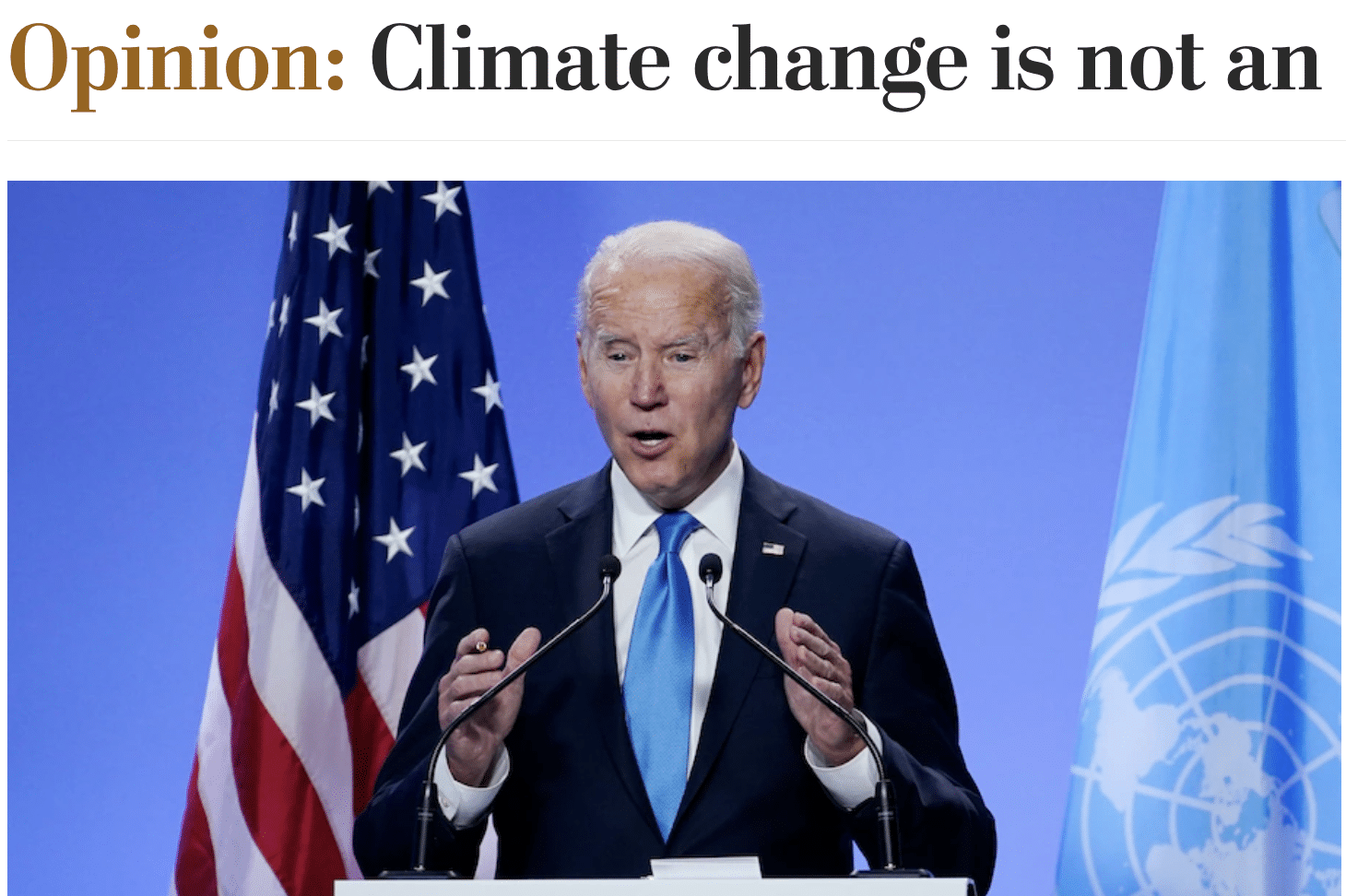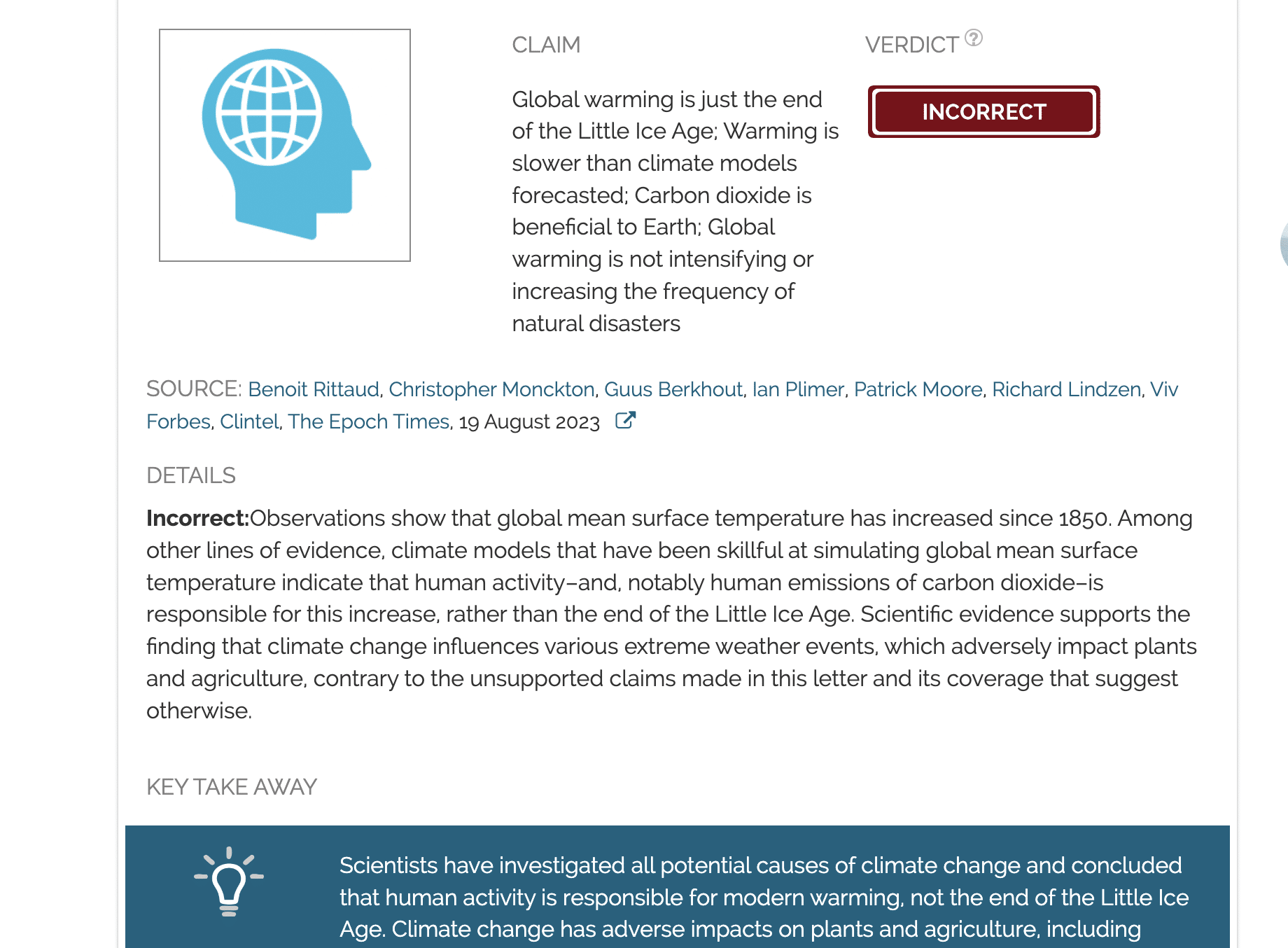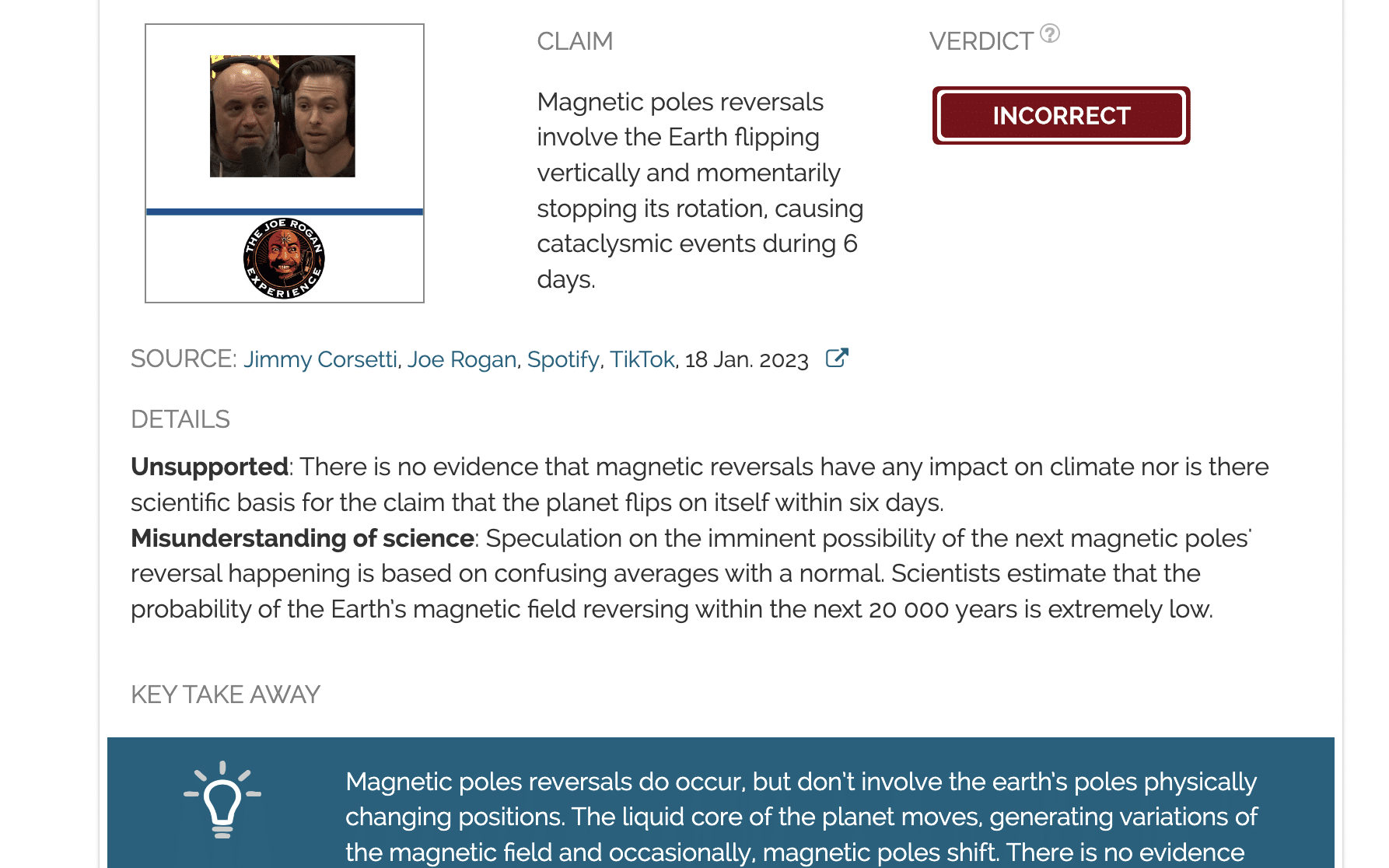Marc Thiessen’s column in The Washington Post relies on incorrect and cherry-picked claims by Bjorn Lomborg; scientists provide needed context

On 2 November 2021, columnist Marc Thiessen published an article in The Washington Post’s opinion section commenting on climate change and the United Nations Climate Change Conference, COP26, in Glasgow, Scotland. Thiessen argues that climate change is a “manageable condition humanity can live with” based on a set of claims made by Bjorn Lomborg; however, one can only reach such a conclusion by ignoring what the science shows about climate change.
We comment on the main verifiable claims made in Thiessen’s article below.
Influence of climate change on temperature-related mortality
One of the arguments used by Thiessen in his article is Lomborg’s claim that global warming saves “166,000 thousands lives” every year. However, this claim is unsupported and has been shown to misrepresent the results of the scientific study it relies on[1]. Professor Yuming Guo, the second author of the study who commented on behalf of the research consortium that led it, indicated to Climate Feedback that Lomborg’s interpretation of the study is incorrect. Lomborg claimed that the study showed changes in cold- and heat-related deaths over the past two decades due to temperature changes, but the study did not investigate whether these changes were attributed to temperature changes or other factors.
Professor Guo explained:
“Cold-related mortality decreased and heat-related mortality increased from 2000 to 2019, causing a net decrease in total deaths. However, it is not correct to interpret that this net decrease was caused by climate change. We just estimated the trend of mortality burden related to non-optimal temperatures, but did not do further analysis to examine whether this change is due to climate change or other factors.”
Aaron Bernstein, an expert on the impacts of climate change on human health from the Center for Climate, Health and the Global Environment at the Harvard Chan School of Public Health, further explained:
“The Institute for Health Metrics and Evaluation (IHME) data cited [by Lomborg] on mortality and cold exposure show that rates of cold deaths have fallen, but those from heat remained roughly the same between 1990 and 2019. However, neither these rates nor the cited papers in The Lancet[1] are directly concerned with mortality risk from climate change.
The issue with Lomborg’s argument is that he is using cherry-picked data that may be compelling in isolation, but belies a firm grasp of the science, which makes clear that unmitigated climate change is a disaster for human health and welfare, even if we may, in the near term, see reductions in cold deaths.”
The fact that Thiessen repeated this mistake in his article shows that he failed to perform a basic fact-check, which is one of the core elements of journalism ethics.
What do scientists know about the effects of climate change on current and expected temperature-related deaths?
Antonio Gasparrini, Professor of Biostatistics and Epidemiology at the London School of Hygiene and Tropical Medicine, told Climate Feedback about studies that investigated the impact of climate change on temperature-related deaths. They paint a picture in stark contrast to the one presented in the Washington Post article[2-5]. Results from a study Gasparrini conducted show that “in many countries, especially in highly populated tropical areas, the increase in heat-related deaths is much higher than the reduction in cold-related deaths, with an increase in net mortality, especially under more extreme scenarios of global warming[6]. Separate analyses led by other research groups[7,8] confirmed these results in both the US and Europe.”
Gasparrini added that “Lomborg and others who…claim that climate change will be beneficial conveniently ignore that we actually addressed this question”. Lomborg used a technique called cherry-picking by ignoring any evidence that ran counter to his predetermined conclusion about the effects of climate change on temperature-related deaths.
Scientific studies show that global warming will be a growing concern in the future, as heat-related deaths will continue to rise[9,10]. A study even found that some regions could become uninhabitable under a high greenhouse gas emissions scenario[9].
Steven Sherwood, Professor at the Centre of Excellence for Climate Extremes and the University of New South Wales, co-authored a study on the limits of human adaptability to heat stress related to climate change[11]. He explained:
“What we do know is that each year thousands of fatalities can now be attributed to the added impact of global warming on the heat waves that were responsible for these fatalities—see here— and that extreme heat is more difficult to adapt to than extreme cold.
The real question is when adaptation reaches its limits. There is no known cold limit. Our paper showed that there is a heat limit[11].”
The ability of humans to adapt to extreme heat is limited in several locations, notably tropical and equatorial regions[12]. The regions where humanity can thrive are expected to shift in the future as the climate warms[13], which could lead to geopolitical issues if migration between these areas increases.
Prof. Bernstein also told Climate Feedback that cutting fossil fuel pollution, which is responsible for climate change, can also have other benefits for human health:
“Air pollution from burning fossil fuels has been estimated to cause 8,000,000 premature deaths–or 1 in 5–each year worldwide. Reducing the use of fossil fuels that are contributing to climate change will have massive health and economic benefits.“
Finally, if one wants to know whether climate change is or will be “saving people’s lives”, one needs to take into account all the impacts of climate change beyond temperature-related deaths alone. Rasmus Benestad, Senior Scientist at the Norwegian Meteorological Institute, told Climate Feedback that these impacts include sea-level rise, which affects people in low-lying islands and coastal regions. Sea-level rise can drive human migration, increasing the risk of conflicts, and it can make storm surges more damaging. He adds that climate change can also favor the spread of vector-borne diseases[14,15], such as malaria, and negatively impact food security[16-21]. Reports that consider the entire body of scientific research, such as those organized by the IPCC, show that the overall consequences from climate change on humans and the ecosystems they rely on are negative[18].
Influence of climate change on human nutrition
In his article, Thiessen relies on Lomborg’s claim that the number of children affected by malnutrition keeps decreasing in spite of climate change and that addressing climate change via a carbon tax would actually “increase the number of people in poverty around the world by as much as 80 million” and “caus[e] far more malnutrition deaths than climate change”.
Samuel Myers, Research Scientist at the Department of Environmental Health in Harvard Chan School of Public Health, explained that “while food security has been improving for the past several decades in parallel to economic growth and reduced poverty, the last five years have seen reversals of that trend”. He adds that “this reversal is likely to be foreshadowing of things to come as we encounter stronger and stronger environmental headwinds”.
For a reader of Thiessen’s Washington Post article, additional context is needed to form an accurate understanding of the negative consequences climate change is expected to have on nutrition. Myers further explained that:
“Rising CO2 not only leads to climate change, which is likely to reduce global crop yields compared to a world without climate change, but rising CO2 is also making our food less nutritious and threatening hundreds of millions of people with nutrient insufficiency. Two of our research papers show the effect of rising CO2 on crop nutrients[22] and the likely impact on human nutrition globally[23].”
Regarding Lomborg’s claim that a carbon tax could increase the number of people in poverty and cause far more malnutrition deaths than climate change, Kenneth Gillingham, Professor of Economics at Yale reacted saying:
“That quote is deeply misleading. It is taken entirely out of context from a paper that discusses how carbon taxes could be used to eliminate poverty around the world. The quote is a cherry-picked number that only makes sense if you assume that all of the carbon tax revenue is effectively thrown away rather than used positively to improve well-being. But in reality the carbon tax revenue could be used to help people, and in fact, the paper cited shows that it could be used to virtually eliminate poverty[24].
Influence of climate change on people displaced by rising sea levels
Scientists confirmed that some of the claims in the article are accurate; however, Lomborg also made up others that have no known scientific support.
In the article, Thiessen quotes Lomborg as saying that “‘110 million people are right now living below sea level’ in places like Holland.” That figure is accurate based on the current literature[25], said Ben Strauss, Chief Scientist of Climate Central. However, Strauss cautioned against Lomborg’s optimistic claim that “the actual number of people [displaced] when you take into account adaptation is probably in the tens of thousands, not in the hundreds of millions”. He further explained:
“The idea that only tens of thousands of people will be dislocated this century, when there are currently about 5 million people per vertical inch above the high tide line globally…seems highly optimistic. It is important to note that a lot of the population protected below tideline today are in places that developed at such low elevations in the first place, and were planned and laid out accordingly (for example, there are lots of space for dikes and levees in the Netherlands—they were built around marshes as they were drained to create more land). Whereas most vulnerable cities and areas were developed with no room or thought for major coastal adaptation. This is likely to be a very expensive proposition—where it is affordable and feasible.”
Conclusion
Thiessen repeated a large number of Lomborg’s claims in his article without fact-checking or verifying these claims by consulting with scientists who actually have expertise on these topics. Readers who are unfamiliar with climate science should note that Lomborg is not an expert on the topics he makes claims about. Unlike scientists, Lomborg writes books and social media posts about a variety of topics, but he does not submit scientific research on these topics to peer-reviewed journals. If Thiessen lacks the scientific knowledge to challenge Lomborg’s claims, he could have done what professional journalists do: reach out to experts to gain insight from them. Without additional context, Thiessen’s article can mislead readers by leaving them with the takeaways that climate change won’t have a negative impact on sea-level rise-induced migrations, human nutrition or temperature-related mortality—takeaways that run counter to scientific findings.
Reviewers’ Feedback
Claim: “In 1990, 7 million children died from malnutrition”. “Today we’re down to about 2.7 million children dying from malnutrition. And in 2050 … we’ll be down to about 600,000.” “It’s really not rocket science, if you’re poor, you’re much more likely to be malnourished and also die from malnourishment. If you get people out of poverty, they don’t die from malnutrition anymore.”
Samuel Myers, MD, MPH, Principal Research Scientist, Department of Environmental Health, Harvard TH Chan School of Public Health
To my mind there are two fundamental flaws with this argument.
The first is that, while food security has been improving for the past several decades in parallel to economic growth and reduced poverty, the last five years have seen reversals of that trend. Ironically, I wrote an op-ed with Peter Huybers at Harvard and submitted it to The Washington Post but they rejected it. Our op-ed essentially made the opposite argument to Thiessen: that trends got worse over the last five years and that this reversal is likely to be foreshadowing of things to come as we encounter stronger and stronger environmental headwinds.
The second flaw is that, even if food security did continue to improve, the question is not whether food security will improve, it is whether food security will improve (or decline) faster or slower in response to climate change. In other words, maybe the last five years are NOT foreshadowing of things to come, and the decadal trend will continue improving food security. But will climate change additionally slow, or accelerate those improvements? There is almost no question that it will slow any improvement (and more likely accelerate declines) in food security. On that, there is strong consensus in the scientific community. In addition, my own research[22,23] shows that rising CO2 not only leads to climate change, which is likely to reduce global crop yields compared to a world without climate change, but rising CO2 is also making our food less nutritious and threatening hundreds of millions of people with nutrient insufficiency. Two of our research papers show the effect of rising CO2 on crop nutrients[22] and the likely impact on human nutrition globally[23].
Claim: “if you’re poor, you’re much more likely to be malnourished and also die from malnourishment. If you get people out of poverty, they don’t die from malnutrition anymore.”
Philip L Staddon, Principal Lecturer in Environment and Sustainability, University of Gloucestershire:
This is a rather obvious statement. There is a finite amount of land to produce food. Many areas are already under water stress and will become more so with climate change. The food security risk will increase in many parts of the world especially in many parts of Africa[26]. If there’s no food being grown, it really doesn’t matter how much more money you might have had. So this argument is clearly overly simplistic and would appear to show a lack of understanding on the basic requirements of crops.
Claim “Lomborg points to a Post editorial that warns rising oceans could “make 187 million people homeless” by 2100. That is true only if you assume that humanity does nothing during the next 79 years to adapt. “What they forget,” he says, “is we have very good technologies to make sure that people are protected. 110 million people are right now living below sea level” in places like Holland. Adaptation, he says, will reduce the number of flooded people 12,000-fold. “The actual number of people [displaced] when you take into account adaptation is probably in the tens of thousands, not in the hundreds of millions.”
Benjamin Strauss, Ph.D., CEO and Chief Scientist, Climate Central
The 110 million figure is appropriate given the current literature—the citation is one of my own papers[25]. (Based on yet-to-be-published research since then, the number is actually lower, maybe 2/3 of that, but still substantial.) So there is a reasonable point to be made that coastal settlement today demonstrates the feasibility of adaptation, at least up to a point.
The 187 million homeless number seems to be based on a PNAS paper from May 2019 that estimated how many people live less than 2 meters above sea level[27]. 187M is a large underestimate, based on highly inaccurate elevation data. The “Supplementary Data 2” file associated with the reference I linked above estimates there are 400 million people living less than 2 meters above the high tide line today (and population will likely grow substantially by 2100). That said, a scenario of 2 meters of sea level rise by 2100 is currently viewed as quite unlikely (though it can’t be ruled out). And of course there is the question of adaptation.
I am unaware of research supporting such a specific claim that adaptation will reduce flooded people by 12,000 times. Also, the idea that only tens of thousands of people will be dislocated this century, when there are currently about 5 million people per vertical inch above the high tide line globally (in the first few vertical yards, based on the same Supplementary Data 2 file), seems highly optimistic. It is important to note that a lot of the population protected below tideline today are in places that developed at such low elevations in the first place, and were planned and laid out accordingly (e.g., there’s lots of space for dikes and levees in the Netherlands—they were built around marshes as they were drained to create more land). Whereas most vulnerable cities and areas were developed with no room or thought for major coastal adaptation. This is likely to be a very expensive proposition—where it is affordable and feasible.
Claim “A global carbon tax, for example, could increase the number of people in poverty around the world by as much as 80 million, causing far more malnutrition deaths than climate change.”
Kenneth Gillingham, Professor of Economics, Yale
That quote is deeply misleading. It is taken entirely out of context from a paper that discusses how carbon taxes could be used to eliminate poverty around the world. The quote is a cherry-picked number that only makes sense if you assume that all of the carbon tax revenue is effectively thrown away rather than used positively to improve well-being. But in reality the carbon tax revenue could be used to help people, and in fact, the paper cited shows that it could be used to virtually eliminate poverty[24].
References
- 1 – Zhao et al. (2021) “Global, regional, and national burden of mortality associated with non-optimal ambient temperatures from 2000 to 2019: a three-stage modelling study.” The Lancet Planetary Health.
- 2 – Vicedo-Cabrera et al. (2021) “The burden of heat-related mortality attributable to recent human-induced climate change.” Nature climate change
- 3 – Kinney et al. (2015) “Winter season mortality: will climate warming bring benefits?.” Environmental Research Letters.
- 4 – Ebi and Mills. (2013) “Winter mortality in a warming climate: a reassessment.” Wiley Interdisciplinary Reviews: Climate Change.
- 5 – Staddon et al. (2014). Climate warming will not decrease winter mortality. Nature Climate Change.
- 6 – Gasparrini et al. (2017) “Projections of temperature-related excess mortality under climate change scenarios.” The Lancet Planetary Health.
- 7 – Weinberger et al. (2017) “Projected temperature-related deaths in ten large US metropolitan areas under different climate change scenarios.” Environment international.
- 8 – Martínez-Solanas et al. (2021) “Projections of temperature-attributable mortality in Europe: a time series analysis of 147 contiguous regions in 16 countries.” The Lancet Planetary Health.
- 9 – Yang et al. (2021) Projecting heat-related excess mortality under climate change scenarios in China.” Nature communications.
- 10 – Lay et al. (2021) City-level vulnerability to temperature-related mortality in the USA and future projections: a geographically clustered meta-regression. The Lancet Planetary Health.
- 11 – Sherwood and Huber. (2010) “An adaptability limit to climate change due to heat stress.” Proceedings of the National Academy of Sciences.
- 12 – Pal and Eltahir (2016) “Future temperature in southwest Asia projected to exceed a threshold for human adaptability.” Nature Climate Change.
- 13 – Xu et al. (2020) “Future of the human climate niche.” Proceedings of the National Academy of Sciences.
- 14 – Kelly-Hope and McKenzie. (2009) “Environmental factors associated with the malaria vectors Anopheles gambiae and Anopheles funestus in Kenya.” Malaria journal.
- 15 – Alonso et al. (2011) “Epidemic malaria and warmer temperatures in recent decades in an East African highland.” Proceedings of the Royal Society B: Biological Sciences
- 16 – Quiggin et al. (2021) Climate change risk assessment 2021. Chatham House Report
- 17 – Betts et al. (2018). Changes in climate extremes, fresh water availability and vulnerability to food insecurity projected at 1.5 C and 2 C global warming with a higher-resolution global climate model. Philosophical Transactions of the Royal Society A: Mathematical, Physical and Engineering Sciences.
- 18 – Smith et al. (2014) Human health: impacts, adaptation, and co-benefits. In: Climate Change 2014: Impacts, Adaptation, and Vulnerability. Part A: Global and Sectoral Aspects. Contribution of Working Group II to the Fifth Assessment Report of the Intergovernmental Panel on Climate Change Cambridge University Press.
- 19 – Nelson et al. (2010) “The costs of agricultural adaptation to climate change.” Development and climate change discussion paper.
- 20 – Andrews et al. (2018). Implications for workability and survivability in populations exposed to extreme heat under climate change: a modelling study. The Lancet Planetary Health.
- 21 – Lake et al. (2012). Climate change and food security: health impacts in developed countries. Environmental health perspectives
- 22 – Myers et al. (2014) Increasing CO2 threatens human nutrition. Nature.
- 23 – Smith et al. (2018) Impact of anthropogenic CO2 emissions on global human nutrition. Nature.
- 24 – Fujimori et al. (2020) An assessment of the potential of using carbon tax revenue to tackle poverty. Environmental Research Letters.
- 25 – Kulp et al. (2019) New elevation data triple estimates of global vulnerability to sea-level rise and coastal flooding. Nature.
- 26 – Mbow et al. (2019) Food Security. In: Climate Change and Land: an IPCC special report on climate change, desertification, land degradation, sustainable land management, food security, and greenhouse gas fluxes in terrestrial ecosystems. Intergovernmental Panel on Climate Change.
- 27 – Bamber et al. (2019) Ice sheet contributions to future sea-level rise from structured expert judgment. Proceedings of the National Academy of Sciences.



